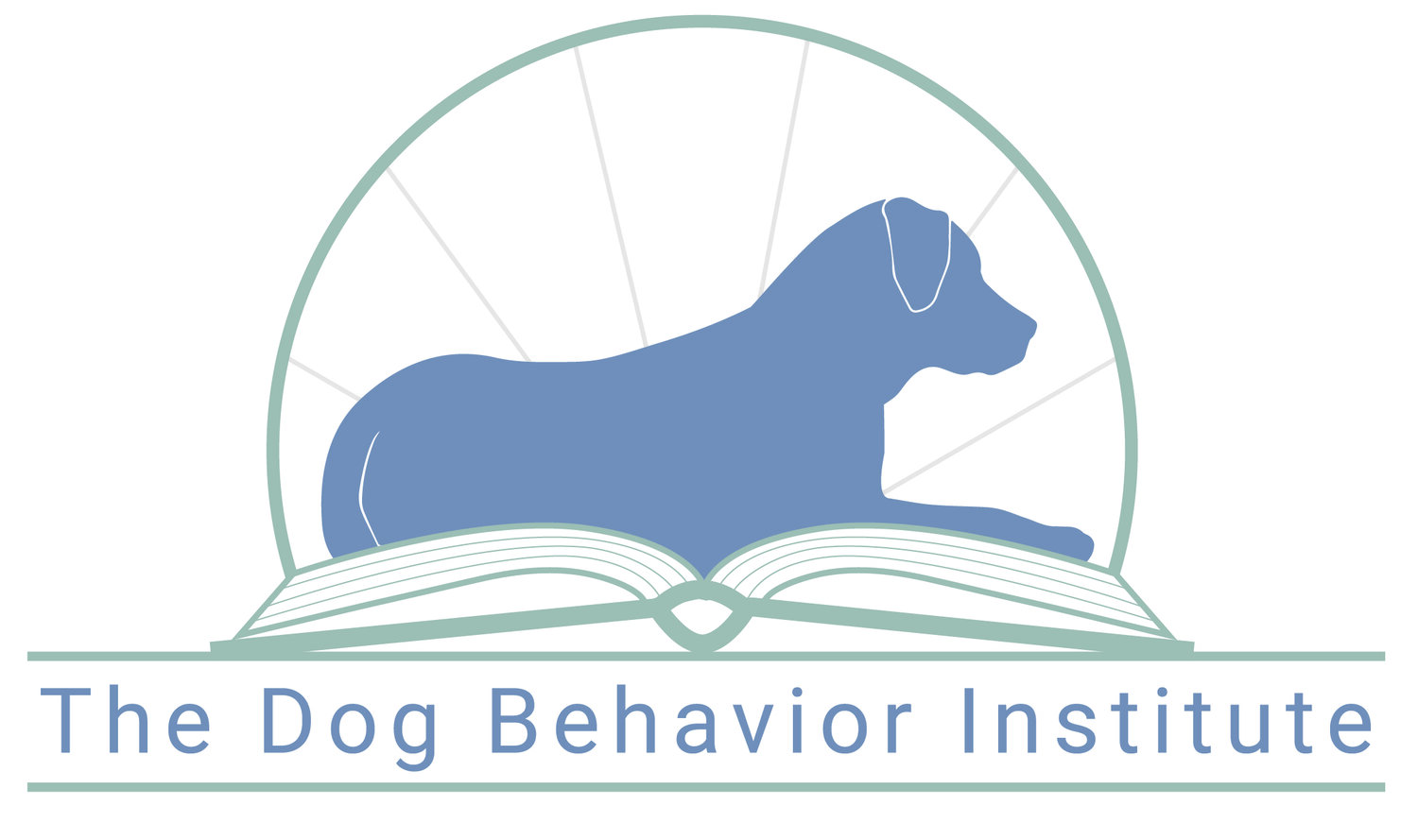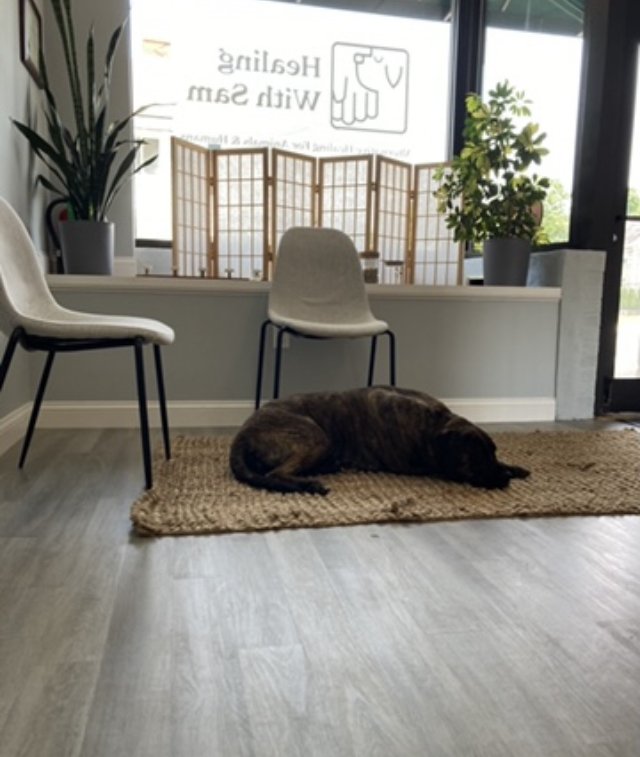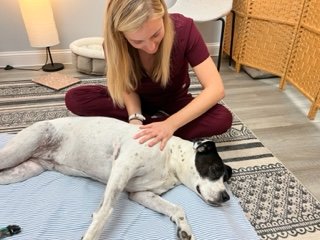Interview with Samantha Hankey, Certified Veterinary Nurse
Introduction
Ran here! At some point I will share more details about my long journey with Beacon and her chronic pain. For now I will just briefly share that, first, it has been a bumpy road, and second, working with Sam has been enormously impactful. Beacon was diagnosed with hip dysplasia and arthritis when she was just over two, and we realized that a lot of things that had seemed like behavior challenges were, in fact, symptoms of pain. As we found appropriate veterinary support (thank you to the amazing team at Sleepy Dog Veterinary!), many of Beacon’s symptoms improved, but there were still some signs of discomfort. As someone who is excited about data, I began tracking some of Beacon’s symptoms on a regular basis.
In the meantime, as we continued to collaborate with the team at Sleepy Dog, worked with a fantastic physical therapist, and spoke with other folks with similar experiences, Sam’s name kept coming up. “Have you tried massage?” At first I brushed this off - massage was not something I had considered. But after the physical therapist, a friend, and finally our vet herself mentioned Sam, I finally reached out, and my only regret is that I didn’t do it sooner.
Beacon has never been a dog who enjoys much petting, but she walked in with her tail wagging, and she has been excited to start our appointment every time we go. She often needs breaks, wandering away during session, and Sam just sits and waits for Beacon to come back - which she always does.
And remember the data I’ve been collecting? What I have found is that Beacon’s symptoms decreased with periodic massages, increased when we took a break from massages for a couple of months, and have plummeted now that we have increased to regular massages with Sam. I’m excited for you to get to know Sam through her interview below!
Interview conducted by Stephanie Keesey-Phelan:
Tell our readers a bit about yourself. How did you decide that you wanted to work with animals (and dogs in particular)?
I have always loved animals and felt a big connection with them. I think it’s so amazing that we are able to have companions of a different species that live in our homes, love us and bring us so much joy. I went to the veterinary nurse program at Mount Ida College where I received my Bachelor’s of Science and became a certified veterinary technician/nurse. Alternative medicine was a big part of my life growing up so I had a feeling that I wanted to do that in the veterinary field. I was often told in school that basically didn’t exist but it turns out it does! Most of my internships involved alternative medicine including psychical therapy and an integrative medicine veterinary clinic that focused on herbs, acupuncture and chiropractic work. I have over 6 years of experience as a veterinary nurse in alternative medicine. I am also trained as a reiki master, small animal massage practitioner and completed programs for acupressure, tui na and cranial sacral work. I met Dr. Innis at my first veterinary nurse job, who is the owner of the amazing Sleepy Dog Veterinary , and I had a strong intuitive feeling that I would go work for her. I ended up working at Sleepy Dog for many years. Then came the time to open my own space for animal massage, reiki, human reiki, etc.
Where do you work and what is your role?
I am the owner and the sole practitioner at Healing with Sam in Lexington. I provide massage, reiki, accupressure, cranial sacral and communication work for animals and reiki for humans. Although I am the only practitioner at my practice I am very lucky to still work closely with the Sleepy Dog Team, some amazing psychical therapists and some incredible trainers. I mostly see dogs, cats and humans at Healing with Sam. On the rare occasion I have seen rabbits, horses, rats and even a llama. I am hoping to start seeing more horses!
What special interests do you have within your field?
I love seeing all kinds of patients/clients but I do really love seeing the nervous or high anxiety cases. Anxiety affects so many different areas of our body (such as our gastrointestinal system and musculoskeletal system) and can make such a difference when it’s more in balance! I love being able to give animals a safe space to come, relax and get re centered. After the pandemic I felt there was a huge need for energy work for both animals and humans. I love being able to work on both. We are so in sync and bonded with our animals. It is so important to take care of yourself, as well as our beloved companions!
When it comes to dog behavior, what have you been seeing in your setting? Are there common behavioral challenges?
I see a lot of dogs with anxiety. I would say the biggest challenge with that though is the pet parent worrying that their pet is going to be too stressed and it won’t work. All they need is patience (and often some good food offerings haha). These cases are not one and done kind of appointments. I would say the average is 3 appointments before a dog that runs on the more anxious side trusts me and we begin to see some improvements. I always remind myself and others that every dog and being is different. Some may respond sooner and others may take a few more appointments. It all comes down to patience and reading the dog to meet them where they are at that time.
What is the process like with your services? How do clients know what is a good fit for their dog?
I would say the process of my services starts before I even meet the dog in person. Before we initially meet I send an intake form with lots of questions on how to make your dog as comfortable as possible during their appointment. These include: does your dog have allergies, would they prefer being ignored and not reached for, would they feel more comfortable without you in the room, would they prefer a basket muzzle and many others!
When the dog arrives at my space I love for them to come right in and start investigating and sniffing. Depending on the dog I usually ignore them at first and let them explore. As they explore I begin to evaluate their body language, gait and so on. I have done my best to create a space that is friendly for all kinds of dogs. It has traction on the floors, raised water bowls, treats available (when and if necessary), mild cleaning smells, etc.
I more often than not begin with distance reiki. I find that animals love reiki and it can have a great calming effect on them when we first meet. If I feel the animal is comfortable and ready I will begin my physical exam and massage work or whatever modality I feel is best for that dog that day. I talk to clients throughout this whole process. I let them know what I am observing and feeling, and discuss how they think their animal is feeling (this is so important to me because the pet parent knows them best and I want them to be as comfortable as their animal is). From there, the pet parent, dog and I decide what would be the best fit for the dog and what would be the most beneficial at that time.
Tell us about your practice space, how is it similar or different from a veterinary office?
There are some similarities between my space and a veterinary office. I still wear veterinary nurse scrubs which I think can be alarming at first to some dogs. I now think it’s beneficial that I wear them, not just for the easy clean up, but because the dogs have a positive interaction with me in them where I don’t have to do anything too invasive.
I have carpets and yoga mats for traction through my space which I think immediately decreases anxiety because I see a lot of patients with mobility issues. I also have screens blocking the windows so there’s less outside stimuli. I am also hoping to put in some shades one day for those who need some extra help tuning out the outside world. If appropriate I have treats to help calm them. I try to keep the smells as neutral as possible.Everyone is also on the floor during the session if the pet parent is able. I’m not standing over the animal or putting them up on a table. I immediately get right down to their level the whole time which I also think makes a big difference.
I do my best to let the animal come to me for their session. I never want to force them to lay down or be in a position that they are not comfortable in. If the animal wants to stand and focus on their Lickimat for the whole time while I work. That is fine with me!
How long are appointments? How long do you see patients?
Appointments are typically about 30 minutes. That seems to be the sweet spot where the animal will get the benefit of the treatment without me pushing their boundaries or asking too much of them (massage and energy work can sometimes be intense. Intense in a good way but intense).
Every patient/client is different but generally when I first start seeing a patient, I like to have appointments closer together. This usually looks like one to two weeks at first and then depending on how their body holds the energy work or massage I’ll try to push it out more and more. I have patients that I was seeing once a week that I now see every four months or so. I have also seen patients who were recovering from a surgery, who no longer need me after a period of time but many of my patients are geriatric or have chronic issues so I tend to see them long term.
Do you recommend your services as part of a preventative approach?
I am a big fan of preventative approaches. Preventative massage is amazing to check in with their musculoskeletal system and to keep the dog as comfortable as possible! Animals can hide so much from us, including pain and discomfort. My sessions can be a great way to get more information about your pet and their body.
In the most ideal world I would love to see the dog before they develop an injury or become too painful. Some people tend to not think about it but if you start working with/on the animal when they are not too painful, they can get familiar with the massage techniques and methods without being too uncomfortable. When they understand and know the routine of what you are doing, it can be easier to work on them even with a tougher or more painful situation where they have the potential to be too worried from being too sore or painful.
I love teaching pet parents safe massage and acupressure techniques to do at home so they also get more familiar with massage between sessions. This is a great help for me to get more work done during a session and it’s also great for the human animal bond!
What is your favorite part of your job?
My favorite part of my job is the joyous response from pet parents telling me their dog is happier, more comfortable or more like themselves after a session. When you are with your animal every day you may not notice that they stopped picking up certain toys, they weren’t sleeping as deeply, or maybe they were hesitating to go up or down the stairs. These are just a few examples but there are so many behaviors and routines that can change when your dog is feeling better. It makes me so happy when I hear a dog's quality of life has improved or they are just a little bit more comfortable/happier.
People have written to me and said they feel closer and have a better bond and understanding with their animals. This makes me so happy because that bond is already so special. If I can emphasize and expand that relationship it makes me feel like I did my job. I love being able to offer different modalities for geriatric, high anxiety and chronically ill pets to keep them comfortable and happy. There are just so many options out there now to improve quality of life for these cases.
I am a big fan of both eastern and western medicine. There is a belief sometimes that I am anti-conventional medicine or against pain medicine. I am not! I love when owners work with their primary veterinarians to come up with a medical plan and the right combination of therapies. This could include pain medicine, massage, acupuncture, cold laser, reiki, physical therapy and many others. So many great combinations for all different situations!
What do you like least about your job?
The least favorite part of my job is when someone wants an instant fix or quick answer to what may be causing an issue. Unfortunately most of the issues and concerns I work with take some time and patience.
What advice would you give to someone who was interested in pursuing your career?
Don’t let anyone tell you that it’s not possible. I’ve been told that one several times. You just need to move right past that because I’m telling you that it is possible! You can do your own research, find programs that you can learn from and create your own tool box for your career. I love having so many tools in my toolbox to offer and you don’t have to stick to one thing. A combination of education, skills and modalities can bring amazing results to your clients. You don’t have to limit yourself. The animal world is so vast and still growing!
Do you have any resources that you think might be helpful for clients with their dogs or to learn more?
One part of my work that is tough but I am so grateful to be able to help people and their animals through this process is geriatric and end of life care. I love an app, Grey Muzzle. It can help you keep records and assess how your pet is doing towards the end of their life. It allows you to record good, bad, okay days, you can make notes on it and it even breaks all the data down into a pie chart. I think this can be so helpful for some people to see. I know that’s a depressing resource to recommend but I have had so many clients that have been grateful for that app because it really helps them to keep track of quality of life during a very emotional and tough time.










